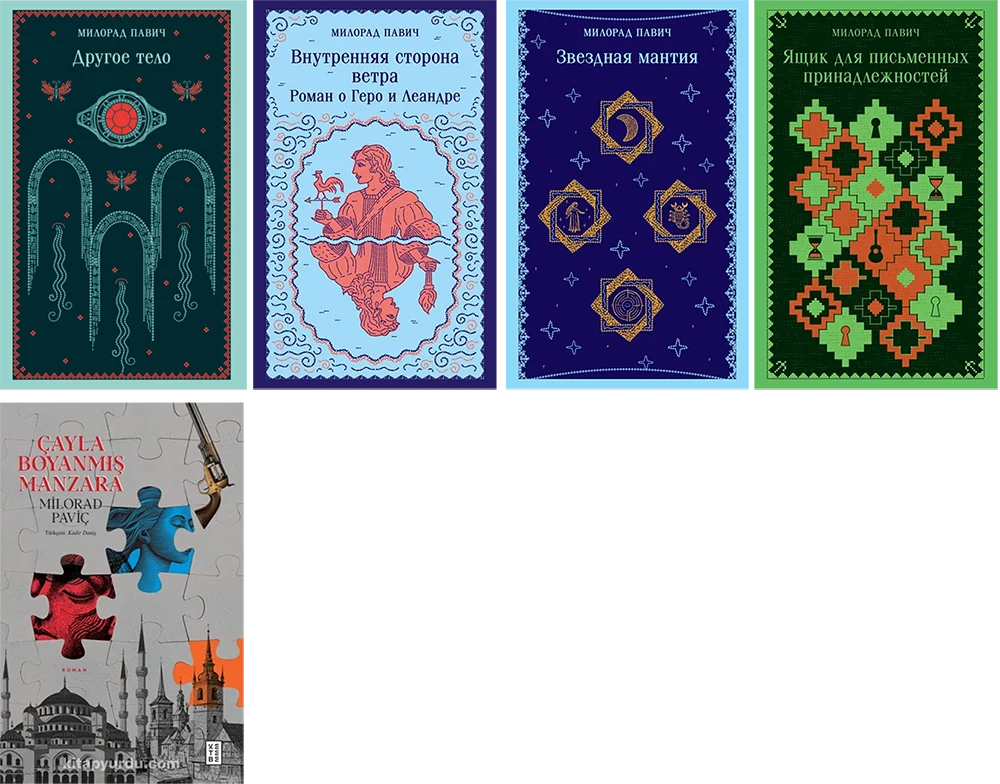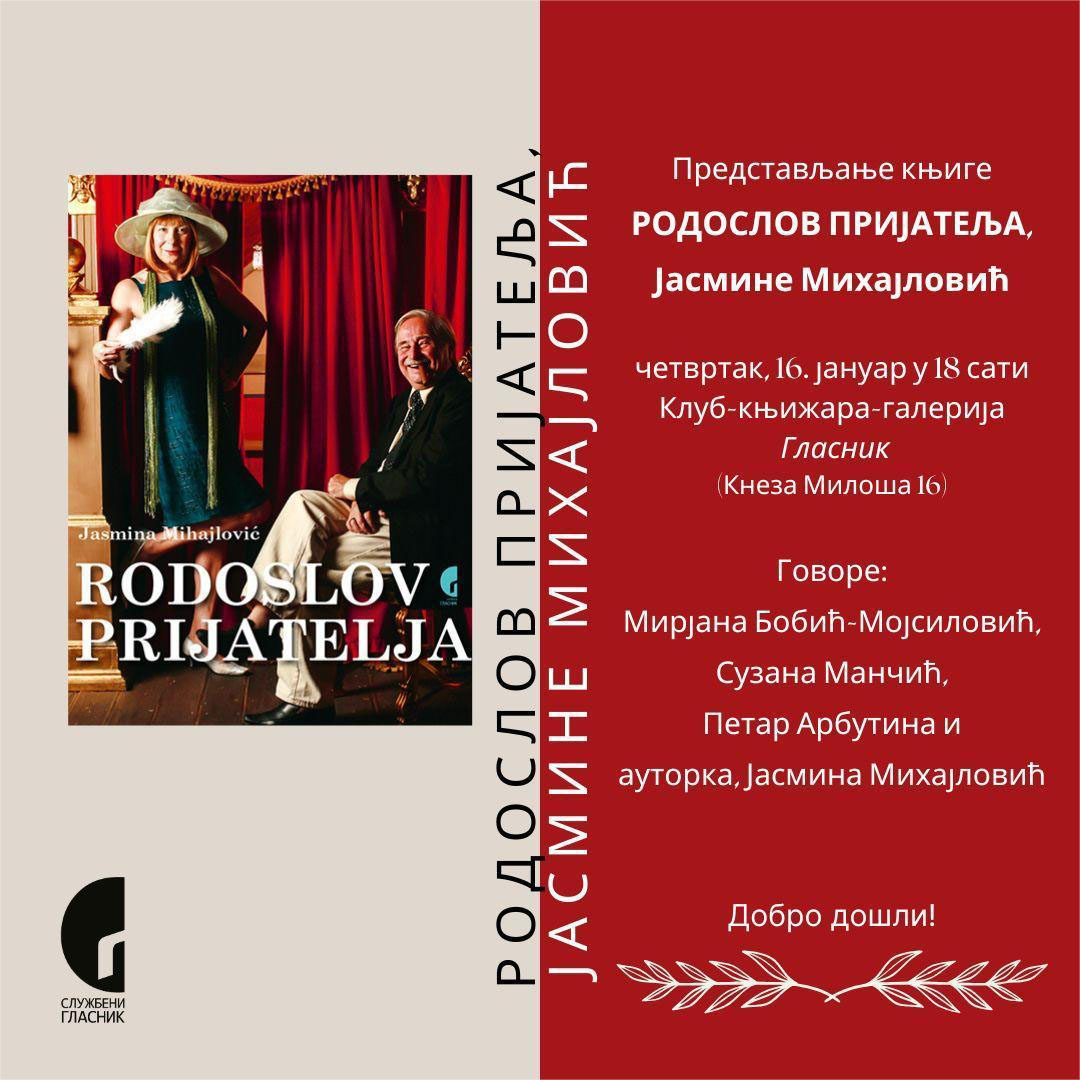Second Body. A Pious Novel
Original title: Drugo telo. Pobožni roman
Basic book data
Second Body is Milorad Pavić’s final novel.
First edition: Belgrade, Dereta, 2006, 310 p.
Translated into English: Dragana Rajkov
- Другое тело (Second Body)
Санкт-Петербург, Азбука, 2007.
Санкт-Петербург, Амфора, 2011.
Санкт-Петербург, Пальмира, 2017. -
Second Body [Kindle Edition e-book]
Amazon.com, Kindle Store, 2010.
Belgrade, Dereta, 2015. (non-Kindle edition) -
Segundo cuerpo (Second Body)
Editorial Sexto Piso, San Miguel (México), 2011. -
Drugo telo (Second Body)
Ma-No, Nova Gorica, 2007. -
Druhé telo (Second Body)
Bratislava, Slovart, 2008. -
Drugie cialo (Second Body)
Warszawa, tCHu, 2007. -
Celalalt trup (Second Body)
Bucuresti, Editura Paralela 45, 2009. -
Другото тяло (Second Body)
София, Колибри, 2009. -
Το Δεύτερο σώμα (Second Body)
ΕΣΤΙΑΣ, ΑΘΗΝΑ, 2008. -
Antrasis kūnas (Second Body)
Lijetuvos rasitoju sajungos leidikla, Vilna, 2007. -
სხვასხეული (Second Body)
Tbilisi, 2009. - Друго тело (Second Body)
Skopje, Zojder, 2017. - 双身记:一部虔诚的小说 (Second body: Pious novel)
Shanghai, Shanghai Translation Publishing House, 2017. -
Москва , ЕКСМО, 2025.
Overview
Milorad Pavić about Second Body
I have lived in two centuries, the 20th and the 21st century. In these two centuries I wrote two novels that I like the most: in the 20th century Dictionary of the Khazars, and in the 21st century Second Body (published recently in Russia and sold in 15,000. copies during January 2007). The Dictionary speaks about my search for three-faced truth in life and I started with it in my youth, about 1952. The Second Body is my recent search for truth after death, because Jesus Christ had and promised to us the “second body“ after death. Both I imagined as religious novels.
*
Notes on the novel Second Body by Milorad Pavić
Milorad Pavić’s new book will for some readers be a love story spanning 4 centuries, and for some a pious novel about the second body of Christ. In any case a proclamation of some important things in life and after it. Two amorous couples in the 18th century and two couples in the 21st century are searching for the second body of Christ and the second body of man. The couples from the 18th century live in Venice and Szentendre (Hungary), and those from the 21st century live all over, from Paris to Belgrade. This “metaphysical thriller”, this love story and new reading of the Bible, speaks, among other things, of what Christ was told on the Mountain by the Angel as he comforted Him before the crucifixion, of where Christ went after his rising from the grave, and which body He had at the time.
Second Body by Milorad Pavić was first published abroad, and then in Serbian. The global premiere of the Second Body was in Russian, in St. Petersburg, by Azbooka. Ten publishers worldwide translated this book straight from the manuscript. The Russian publisher said of this novel: “Milorad Pavić’s novel Second Body is a kind of Slavic parallel to the Da Vinci Code by Dan Brown. Besides what Dan Brown said about the female principle bringing it back into the tale of Christ, there are some other important things that the Christianity of the 21st century can offer mankind. For example, the second body of Christ, which, according to His own words, man can also attain. This, the second body, is what Pavić’s book is about.”
Reviews
The Second Body. A Pious Novel by Turi Robert
The intellectually endowed love adventures are, as one already expects, collaged in a non-linear way in this belletristic texture. The subtle time-scheme ranges from the eighteenth through the twenty-first century in various European venues: Belgrade, Paris, Venice, Szentendre. The key character is Elizabeth (Lisa) Amava Arzuaga Eulohia Ihar-Swift (nicknamed Imola), whose full name the reader discovers only at the end. She is the final custodian of the secret to the second, other body. The book’s protagonist is the fictional narrator-author; he stitches the plots together and slaloms among several public but mostly personal texts and, by balancing between the level of existence and non-existence, creates a crossroad of stories that is left, at points, for the reader to inter-act with.
Among the characters Pavić employs in his fictive world are historical persons. They are Zaharije Orfelin (1726-1785) and Gavril Stefanović Venclović (the second half of the seventeenth century through the mid-eighteen century), figures of crucial importance, whom literary historian Pavić rediscovered for the history of Serbian literature. Orfelin, who spent most of his life in Venice, was a Renaissance man: he had a printing business but was primarily a poet, writer and composer; besides, he was the first to publish in the eighteenth century texts pertaining to Serbian cultural history. Venclović lived in Szentendre, then part of the Habsburg Monarchy. He arrived with the Serbs who, aiming to escape the Turkish rule in the Balkans migrated north. Venclović was an Orthodox monk who wrote poetry and liked to paint. As a man of arts and letters, he contributed to language innovation, while his progressive ideas made him oppose several dogmas of the religious institution he was member. A liberal mind, he believed in women’s right to determine their fate in society.
The novel is divided into three romantic fragments in which women and an enigmatic ring have crucial roles; all are markers of a given present-time. Pavić visualizes the presence of discussed topics (especially the ones that resist visual representation, like time) in drawings at the beginning of chapters and in passim. On page 224, the reader can actually see Pavić’s time-coordinates and the symbolic birth of the present time. Earthly timeline, conceived as a tool of the devil, is presented as running from left to right, similar to the route of writing (and reading) in Western civilization; eternity belongs to the realm of angels and it is symbolized by a descending vertical line. In the tangential point of these two lines lies a present tense, which is the narrated present of the novel. Interestingly, this moment belongs almost entirely to women characters, they seem to make the present of the story.
http://publications.ceu.hu/node/24578
Editors Reviews
Milorad Pavić, the acclaimed Serbian writer and literary historian, was born in Belgrade in 1929. His unconventional novels can be compared with those of Jorge Louis Borges, Julio Cortázar, Umberto Eco, Italo Calvino, and B.S. Johnson; his playful style made Robert Coover claim that Pavić “thinks the way we dream.” A member of the Serbian Academy of Science and Arts since 1991, he lived and worked in Belgrade.
In The Second Body Pavić as always, relies on the active partnership with the readers and lets them choose: whether to experience this novel as a love story, or as a metaphysical thriller about the other, the second body of Jesus Christ. Some critics define the novel as the Slavonic parallel of The Da Vinci Code, as far as it`s suggesting a new interpretation of the Bible.
Editorial Reviews – Kindle e-book
The author of this book is imaginary; the rest of the characters mostly existed. The Spring of the Virgin Mary mentioned in these pages can be found near the house of the Holy Virgin Mary in the town of Ephesus, now Turkey. The ring in the tale also exists. We saw it at a friend of ours’. It changes color depending on the state of its bearer’s body. The two authors talked of in this novel also lived – Gavril Stefanović Venclović (cca 1680-1749?) and Zaharija Orfelin (1726-1784). One lived in Sent Andrea, in Hungary, and the other for a while in Venice. Their works mentioned and quoted here can be read to this very day. In 1772 Venetian printer and publisher Teodosije published Orfelin’s voluminous biography of the Russian Tsar Peter the Great, one of the most finely illustrated books of the time, today read as an exciting novel. Alexander Pushkin had it in his library and studied it carefully. 18th century Venice also had a famous orphanage for the incurable (Conservatorio degli incurabili). All in all, many of the people in this book really did live in their day, for example the musician Zabetta, or Cristofolo Cristofoli, Venetian inquisitor of the 18th century, but their fates were lost in the darkness of time, and have been reformulated here.
http://www.amazon.com/Second-Body-ebook/dp/B0043VE09O
Readers Reviews
-
Second Body - or the Pious novel
This online novel is a very powerful meditation about God, Creation, resurrection and what Christ meant to humanity.
It is written in 5 chapters following a mysterious ring that is rumored to discern what the wearer will have in life - health, love or happiness depending on which color it turns, but somehow it always turns a color if any only when the wearer is dead. So what does it mean?
Chapter 1, 3 and 5 are contemporary following the narrator, an elderly writer who is already 40 days dead at the beginning of the novel, his strange and strangely met wife, and several other mysterious characters, real and supernatural.
Chapter 2 is about a Serbian emigre writer/editor in Venice ~ 1764 and his adventures and misadventures with some venetian girls, Anna and Sabetta.
Chapter 4 is about an orthodox Serbian under-priest - "hieromonk" on the border between the Hapsburgs and the Turks from 1717 to some decades later and his fateful encounter with a catholic priest and reputed alchemist and necromancer. This chapter is the philosophical heart of the novel and the discussion between the two encapsulates it perfectly. I am not an expert in theology so I have no idea how original are the arguments there - but they are very interesting and it makes the book worth reading only for that.
Whimsical, always interesting and beautifully written, Second Body is an extraordinary novel, a coronation of a magistral career. Read it for free at the link above.
As an aside - there are some typos here and there, and chapter 3 ends with chapter 4 included, so if you join the files as I did to read on some device do not be surprised to see a repeat - and I think it is not intentional since chapter 4 is headlined in the repeat - though with Pavic you never know. But hey, it is free so no quibbles.
Friday, May 16, 2008
http://liviu-5.blogspot.com/2008/05/last-love-in-constantinopole-and-second.html






